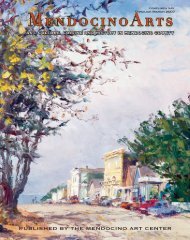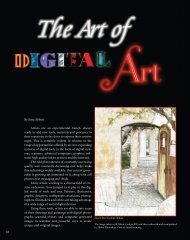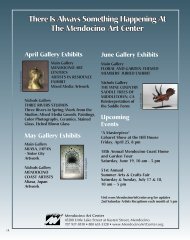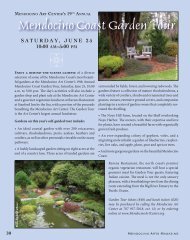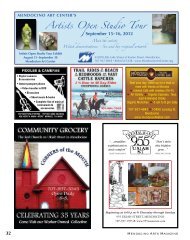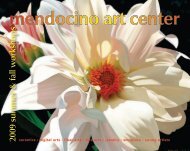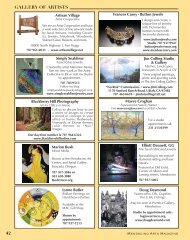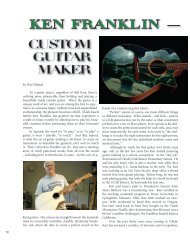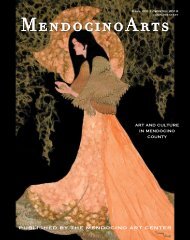Kodiak Greenwood - Mendocino Art Center
Kodiak Greenwood - Mendocino Art Center
Kodiak Greenwood - Mendocino Art Center
You also want an ePaper? Increase the reach of your titles
YUMPU automatically turns print PDFs into web optimized ePapers that Google loves.
<strong>Kodiak</strong> <strong>Greenwood</strong><br />
by Peggy Templer<br />
<strong>Kodiak</strong> <strong>Greenwood</strong> is a native of both Big Sur<br />
and the <strong>Mendocino</strong> Coast, and he cites those landscapes<br />
as major inspirations in his development as a<br />
photographer and artist.<br />
Born in Big Sur, and a current resident there,<br />
he came to <strong>Mendocino</strong> at a young age to live with<br />
his father, and attended <strong>Mendocino</strong> schools through<br />
high school. His father was poet, writer and environmentalist<br />
Robert <strong>Greenwood</strong>, friend and contemporary<br />
of Byrd Baker. The family has ties to the old<br />
logging community of <strong>Greenwood</strong> (Elk).<br />
<strong>Kodiak</strong> was always artistic, constantly drawing<br />
and painting from a very early age. His first introduction<br />
to photography came at age 12, on summer<br />
vacations, when he travelled to British Columbia<br />
with his father, who had given him a camera to<br />
take along on the trip. His<br />
love affair with landscape<br />
photography began then,<br />
capturing the magnificent<br />
mountains, lakes and skies<br />
of Canada.<br />
He describes himself<br />
as “a distracted artistic kid,<br />
not much of a student.”<br />
He was more interested<br />
in surfing, playing lacrosse<br />
and taking photographs<br />
than studying. Although<br />
he struggled in school, he<br />
nonetheless was inspired<br />
and influenced by the<br />
teachers he had at the old<br />
<strong>Mendocino</strong> alternative<br />
high school, then called<br />
<strong>Mendocino</strong> Academy.<br />
His teachers included Julie<br />
Brazill, Mike<br />
M o r e l a n d ,<br />
Bill Lemos,<br />
Beth Ryan and<br />
Adam Strupp.<br />
Bill Brazill, his<br />
photography<br />
teacher, was<br />
the first one to<br />
teach him the traditional and alternative techniques<br />
of photography. In addition, a friend and photographer<br />
from Elk, Justin Lewis, provided adventure<br />
and inspiration – the combination of the outdoors,<br />
nature and cameras were a perfect fit for the two<br />
of them. They spent hours hiking through the hills<br />
and along the empty beaches of the Lost Coast and<br />
p h o t o g r a p h e r<br />
6<br />
Big Sur Coastline
Full Moon and Wildfire, Big Sur<br />
the Headwaters, often sleeping overnight in their pickup<br />
trucks to catch the sunrise, with cameras always at the<br />
ready.<br />
After high school, <strong>Kodiak</strong> and several friends went<br />
to Indonesia on a six week surfing safari, which he documented<br />
with his Nikon N80. He returned from that trip<br />
with such a compelling interest in photography as a possible<br />
career that he went to Santa Barbara to check out<br />
the prestigious Brooks Institute of Photography. He was<br />
Zion, Water Crevice<br />
completely enthralled with what he found there, and<br />
couldn’t get over the idea that doing a classroom<br />
assignment meant taking photographs! He enrolled<br />
at Brooks and completed the three year program and,<br />
a sure indicator of his passion for photography, this<br />
former distracted student graduated with honors.<br />
Three teachers at Brooks, Nick Dekker,<br />
Christopher Broughton and Paul Meyer, were<br />
particularly inspirational, not only for their technical<br />
mastery, but for their emphasis on following your<br />
heart and your passion. Broughton taught him the<br />
importance of previsualization, of seeing the composition<br />
in your mind as you want it to appear in the final<br />
image. Nick Dekker, a friend fond of the Big Sur, taught<br />
the advanced fundamentals and the use of large format<br />
cameras.<br />
<strong>Kodiak</strong> returned to Big Sur after graduating from<br />
Brooks, determined to make a living at photography while<br />
living in the natural environment that inspires him (“the<br />
bohemian history of Big Sur was a continual influence on<br />
the development of my artistic vision,” he says.). His<br />
career really accelerated with architectural and travel<br />
photography assignments, which he continues to do.<br />
He is currently working on a book about the history of<br />
bohemian handmade houses in America and Europe<br />
which is due to be published in 2011 by Rizzoli.<br />
<strong>Kodiak</strong>’s chief passions are nature, travel, and environmental<br />
photography. Recent assignments took<br />
him to the World Climate Conference in Copenhagen;<br />
the Atlas mountains in Morocco; Sardinia, Italy; Fiji<br />
and more. In addition to photographic assignments,<br />
<strong>Kodiak</strong> specializes in fine art photography featuring<br />
nature and landscapes, and his work is in several private<br />
collections. For his fine art photos, <strong>Kodiak</strong> uses<br />
both color and black and white and prefers, rather<br />
than digital, a large format camera, film, and a darkroom.<br />
<strong>Kodiak</strong>’s work has won a number of awards, and<br />
has been featured in many prominent publications,<br />
including The Los Angeles Times, National Geographic<br />
Adventure Magazine, Conde Nast Traveler, The New<br />
York Times, Travel & Leisure, The Washington Post,<br />
San Francisco Chronicle, Santa Barbara Independent,<br />
New Zealand Magazine and others.<br />
To see more of <strong>Kodiak</strong>’s work, visit his website at<br />
www.kodiakgreenwood.com, or contact him by email at<br />
kodiakgreenwood@gmail.com for more samples of his<br />
work.<br />
7
Cover Feature<br />
Birgit O’Connor<br />
Birgit O’Connor has long been one of the most<br />
popular and highly-regarded artists teaching in the Fine<br />
<strong>Art</strong>s Department at the <strong>Mendocino</strong> <strong>Art</strong> <strong>Center</strong>. She is<br />
a self-taught artist who works exclusively within the<br />
challenging media of transparent watercolor, and is a<br />
nationally and internationally sought-after instructor.<br />
Birgit says about her work, “I strive to show that<br />
Canna With Water Drops<br />
watercolor can be bold, rich and dramatic.<br />
“I feel that when you are accustomed to seeing<br />
something in the same way day after day you seem to<br />
forget the beauty that is held within it. I feel as though I<br />
have the opportunity to take someone into a place they<br />
have seen before and give them a different perspective.<br />
I would like people to feel as if they could be part of<br />
another world. To see beauty and simplicity, within that<br />
complexity.<br />
“Within the challenging media of watercolor, I am<br />
able to express my interpretation of Nature’s unique<br />
beauty. I began painting landscapes and have enjoyed<br />
painting mist and valleys, homes and gardens. I found<br />
that my paintings reflected the way that I viewed the<br />
world – as from a distance. As I grew in my art, I became<br />
fascinated with the unusual, the odd little corners of<br />
a backyard, the world within the flowerbeds. I began<br />
studying the intricate details of these hidden places, like<br />
the layers of overlapping leaves and petals, the shadows<br />
and the water droplets. Retrospectively, I liken this to the<br />
increasing complexity of my own thoughts.<br />
“Fascinated with depth, shadow and movement,<br />
I found that the watercolor medium gave me a feeling<br />
of working with subconscious emotion, that the landscape<br />
or the flower itself became a vehicle for color and<br />
form.”<br />
Birgit lives in Bolinas, California, but has had a<br />
long and fruitful relationship with the <strong>Mendocino</strong> coast:<br />
“The <strong>Mendocino</strong> coast has always been a special place to<br />
me. When I was a child my family would come to this<br />
area to camp while my father would dive for abalone.<br />
We would stay at Van Damme, Albion, and Russian<br />
Gulch, to name just a few. This area has always had<br />
such an inspiring magical quality to it, which I now try<br />
8
to bring into my paintings. The<br />
clear water in which you can see<br />
to the bottom and the sounds of<br />
the waves and buoys have inspired<br />
many of my seascapes and paintings<br />
from the shore. The spring blooms<br />
of rhododendrons and azaleas, and Santa Barbara<br />
summer’s Peruvian lilies, Matilija<br />
poppies, and the pink naked ladies that line many of the<br />
older gardens have inspired many of my floral paintings.<br />
“I remember coming to the <strong>Mendocino</strong> <strong>Art</strong> <strong>Center</strong><br />
in the beginning of my career and thinking what a<br />
wonderful place this would be to paint. Now, as an<br />
established artist, it is like a dream come true to be<br />
here sharing my knowledge with others. The <strong>Art</strong> <strong>Center</strong><br />
has such a great location, where students are in walking<br />
distance of many of the inspiring subjects that we<br />
paint. Many times a workshop at the <strong>Art</strong> <strong>Center</strong> has<br />
become a life changing experience for some of my<br />
students, as the class, the environment, the location<br />
and synchronicity of events combine for a magical<br />
experience. The wonderful thing about the <strong>Art</strong> <strong>Center</strong><br />
is that students are able to stay at this facility and take<br />
a workshop for a reasonable price and are often able<br />
to paint late into the night. The <strong>Mendocino</strong>, Fort<br />
Bragg area is a special place where magic happens and<br />
long lasting friendships are made.”<br />
Birgit says, “I am a self-taught artist inspired by the<br />
stories of my family. I thought that it would not be possible<br />
to be a recognized woman artist. I developed my art<br />
while having a family, being a full-time wife and mother.<br />
Currently I am represented in collections around the<br />
world, and my work has appeared in more than 35 publications.<br />
I believe in dreams.”<br />
Birgit is the author of two books, Watercolor in<br />
Motion and Watercolor Essentials (published by North<br />
Light Publications), and her production company,<br />
Purple Gate Productions, has produced<br />
16 instructional DVDs. Many art teachers and<br />
schools are now using these books in their curriculum<br />
or as required reading material. The DVDs<br />
are available on her Web site www.birgitoconnor.<br />
com or as a downloaded version through www.<br />
artworkshops.tv or www.artistsnetwork.tv<br />
Birgit will be teaching several workshops this spring<br />
and summer at the <strong>Mendocino</strong> <strong>Art</strong> <strong>Center</strong>: April<br />
24-26, “Rhododendrons”; July 12-15, “The Essence<br />
of the Flower”, and July 17-18, “Rocks, Shells, Sand<br />
& Shore”.<br />
Rocks, Shells, Sand & Shore<br />
9
Larry driving the <strong>Art</strong> Car in the <strong>Mendocino</strong> Fourth of July Parade, 2009<br />
© Nicholas Wilson<br />
LA R R Y F U E N T E :<br />
N EI G H B O R H O O D V I SI ON A R Y<br />
by Michael Potts<br />
Toasters, rhinestones, plastic figurines, antique<br />
picture frames, and millions of assorted beads encrust<br />
the walls of Toad Hall’s 32 rooms: precious art supplies<br />
Larry Fuente has amassed over the decades.<br />
Larry’s <strong>Art</strong> Car and Game Fish are familiar to admirers<br />
in venues as unlike as <strong>Mendocino</strong>’s Fourth of<br />
July Parade and the Smithsonian’s Renwick Gallery.<br />
“There must be fifty projects in progress here... and<br />
regress then progress again,” Larry explains. “I<br />
started Mona Looza in 1989,” he says, introducing a<br />
bespangled mannikin, part of a planned all-girl punk<br />
jazz rock band installation. “Hopefully, I’ll finish her<br />
before I die. Mostly, I’m janitor, taking care of...” –<br />
he gestures meaningfully at the walls and ceilings,<br />
every square inch embellished with a jack-daw’s<br />
delight of shiny treasures – “… the art supplies.”<br />
After a typically unconventional upbringing near<br />
Chicago and a couple of years at the Kansas City <strong>Art</strong><br />
Institute, Larry found himself, one day in 1968, walking<br />
up a street in Larkspur, California’s Madrone<br />
Canyon looking for a telephone. Instead he found his<br />
artistic guru. “Mandalas, a treehouse... Everywhere I<br />
look, something new. Finally, a human: a wild-eyed<br />
goat god melting colored candle wax onto his curlytoed<br />
Aladdin shoes. ‘Use your phone’ I ask.” When<br />
Larry met psychedelic artist Dickens 44 Bascom, “I<br />
was living a very regulated life, but wanted to be<br />
free. For me, ‘breaking out’ meant painting on walls<br />
10
“Samurai Swordfish” 1986, 36” x 96”. “Dangerous decor. In case of fire, leave<br />
area immediately (with fish if possible).”<br />
instead of stretched canvas. Here was Dickens, raiding<br />
people’s basements for ‘art supplies’ and hanging<br />
stained glass windows from their trees, spreading his<br />
‘Undeniable Breakthroughs’ like fungus down the canyon.<br />
‘Everything’s Okay’ was his mantra. Great ideas,<br />
but poor execution. I could see how to do better.”<br />
When men in white coats arrived in an ambulance,<br />
Larry and Bascom made a break for West Marin to continue<br />
hanging art from trees and engaging neighbors in<br />
making art. “He was an expert at getting people, whole<br />
families, to do art together.” The art and the lifestyle captivated<br />
Larry. Gentle reader, you cannot be surprised to<br />
learn that mind-bending substances were involved. This<br />
was the Summer of Love, a time for Merry Pranksters.<br />
Larry found his way to <strong>Mendocino</strong>, joining selfdescribed<br />
woods hippies living in a meadow in the State<br />
Forest. Foresters knew<br />
they were there, but<br />
didn’t know what<br />
to do about them,<br />
so that summer they<br />
were left alone. “It<br />
was a magnificent<br />
summer, naked in<br />
Big River, my girlfriend<br />
pregnant,<br />
meeting<br />
people from everywhere, getting my mind<br />
blown on every level. I was so impressionable...<br />
“The Street is where I want to be. Elsewhere,<br />
museums and galleries tell you when they open and<br />
close... but the Street is always On.” Larry’s iconic<br />
wheeled works began with the prize winning float<br />
he and Bascom entered in Larkspur’s Fourth of July<br />
Parade. Powered until its clutch burned out by “The<br />
People’s Car,” also known as The Millennium Falcon,<br />
the float featured George Washington in a gas mask<br />
and a precious Blue Willow plate gleaned from the<br />
Larkspur Free Store. “You see, better stuff makes better<br />
art,” Larry explains triumphantly. Other memorable<br />
rolling artworks include Cowasaki, a street-legal<br />
three-wheeler that looks like a Hereford cow and<br />
roars like a muscle car, and Derby Racer, declared<br />
“Most Beautiful Car” in the San Francisco Museum<br />
of Modern <strong>Art</strong>’s 1978 <strong>Art</strong>ist’s Soapbox Derby.<br />
Larry’s life and work rival Salvador Dali’s.<br />
Larry’s antic collection of found objects and meticulously<br />
accretive style find their equal only in<br />
Dali’s ornate Figueres, Spain, museum. Both artists<br />
wring inspiration from the interplay between<br />
language and vision. Like Dali, Larry is a press magnet:<br />
Dali gets the cover of Life, Larry gets National<br />
Geographic. While many belittle their art, both<br />
sold works to the most renowned art institutions.<br />
Asked what motivates him, Larry takes a moment,<br />
his eyes roaming the art supply laden walls. “I guess<br />
most artists are stretching for immortality,”<br />
he replies, his gaze still wandering.<br />
“I’ve got that covered. Game Fish is one of<br />
very few permanent displays at the Smithsonian.<br />
11
Derby Racer #2, 1978. “Power Source: energy captured from bowlers’ ‘frozen motion’<br />
ecologically sound.”<br />
The 100% street legal <strong>Art</strong> Car on Main Street, <strong>Mendocino</strong>, Fourth of July Parade, 2009.<br />
© Nicholas Wilson<br />
Hey, I’ve got my own section in the gift shop!”<br />
He refers to a nearly ten foot long sculpture of a<br />
sailfish adorned with thousands of game pieces –<br />
poker chips, badminton birdies, ping pong balls,<br />
dice – that was purchased by the Smithsonian in<br />
1991. After being displayed for a decent interval,<br />
it was routinely warehoused along with the<br />
Institution’s million-plus other artifacts. The<br />
resulting outcry from visitors returning specifically<br />
to see the piece propelled Game Fish<br />
back onto a prominent wall. It is still counted<br />
among the Smithsonian’s Top Ten highlights.<br />
His eyes focus and his face takes on a hawklike<br />
intensity. “An artist has the obligation – no,<br />
wrong word – the opportunity and obligation, to<br />
see what’s really going on, to reveal.” His voice<br />
hammers the emphasis on revelation. “Drugs,<br />
and the visions they bring, force me to evolve,<br />
and at times I have no idea what I’m doing.<br />
Sometimes this leads to deep depression... but<br />
luckily I have friends to buck me up. I am, and<br />
have been, a political animal all my life. This<br />
article seems like a great (and possibly last)<br />
opportunity to ‘introduce’ myself to my neighbors<br />
and friends (who all think they know me.<br />
They don’t.)”<br />
12
“At the Cafe” by Mike Smart, watercolor<br />
<strong>Art</strong> Explorers, Inc.<br />
A nonprofit program with studio<br />
and gallery. Offering unique and<br />
affordable art, hand-made crafts<br />
and cards.<br />
Open Tuesday, Thursday and<br />
Friday 9-3; Saturday 12-3.<br />
305 E. Redwood Ave. Fort Bragg<br />
707 961-6156<br />
• Ceramics<br />
• Sculpture<br />
• Paintings<br />
• Jewelry<br />
• Furniture<br />
• Photography<br />
Laurel Street<br />
FORT BRAGG<br />
17 <strong>Mendocino</strong> County <strong>Art</strong>ists!<br />
Open Daily 10-6<br />
356 N. Main St, Fort Bragg<br />
www.edgewatergallery.net<br />
964-4668<br />
View more Edgewater <strong>Art</strong> in this issue’s Gallery of <strong>Art</strong>ists!<br />
L aurel S treet<br />
FORT BRAGG<br />
In the garden filled corner of<br />
Main and Evergreen streets<br />
Comfortable rooms & suites with<br />
private baths, beach access,<br />
fresh baked continental breakfast<br />
800-780-7905<br />
www.alegriaquartet.com<br />
13
y Peggy Templer<br />
Danish sculptor Gert Rasmussen loves to work<br />
with steel. Even though he has worked in other media,<br />
he keeps coming back to the clean lines and simple<br />
forms of metal. “Steel is<br />
so different from other<br />
media,” he says. “For one<br />
thing, you can’t actually<br />
touch it while you’re<br />
working with it.” He likes<br />
the way it moves, and the<br />
way it “stands up to anything.”<br />
Gert started out,<br />
as many artists do, as a<br />
youngster preoccupied<br />
with drawing. In his<br />
family’s living room in Copenhagen, Denmark, was<br />
a “presentation black board,” always up, and Gert<br />
would spend hours in front of it, drawing with chalk.<br />
For the boy, the “possibility<br />
of being an<br />
artist was far-fetched<br />
but always on my<br />
mind.” At age 15,<br />
Gert dropped out of<br />
school to apprentice<br />
as a steel fabrication<br />
worker. He also<br />
went to “decoration<br />
school,” learning to<br />
design posters and<br />
do window dressing<br />
and other promotional<br />
artwork in the days before computers.<br />
In 1975, Gert moved to Sweden with his wife<br />
and children and began working for a large glass<br />
company, Kosta Boda, that<br />
also did smith work. His<br />
job was to fabricate fancy<br />
candelabras, fountains, and<br />
an array of other pieces<br />
from designs given to him.<br />
This job put him in touch<br />
with some well-known artists<br />
and designers, including<br />
the glass artist Bertil Vallien.<br />
Gert’s employers “turned<br />
him loose” in their facility,<br />
allowing him unlimited<br />
after hours access to acres of junk, glass, brick, clay,<br />
steel – “ruined things” – as well as the entire smithy.<br />
He began designing and creating his own pieces<br />
and began to seriously<br />
consider himself an artist.<br />
(In fact, from a very<br />
young age Gert identified<br />
with the artist Van<br />
Gogh, possibly because<br />
he was self-taught, possibly<br />
because of the<br />
“misunderstood artist<br />
thing,” and perhaps<br />
because of the slight<br />
disconnect with reality!).<br />
When the Kosta<br />
14
Boda facility shut down, Gert returned<br />
to Denmark, and worked on state<br />
funded art programs for schools. He<br />
again came into contact with some<br />
outstanding artists and designers, and<br />
the school projects were exceptional.<br />
He recalls one project that involved<br />
filling an unused elevator shaft with<br />
hanging sculptures. Not able to get<br />
his own smithy going, during this time<br />
Gert started making jewelry and also<br />
doing some glass work. He became a<br />
“practicing artist,” making and selling<br />
paintings, castings, metal work, jewelry<br />
and ceramics.<br />
Gert’s ex-wife returned to the<br />
United States (to Berkeley/Marin) with<br />
their son in 1990, and Gert came over<br />
for a visit and stayed. They bought<br />
and operated a 54-acre vineyard<br />
in Middletown for a few years, but<br />
moved to <strong>Mendocino</strong> when schooling<br />
for their young son became an issue.<br />
When they moved to <strong>Mendocino</strong>,<br />
they knew only that the schools were<br />
good; Gert knew nothing about the<br />
<strong>Mendocino</strong> <strong>Art</strong> <strong>Center</strong> and was<br />
“astounded” to find such a complete<br />
facility in the small coastal town. He<br />
jumped right into the art scene in<br />
<strong>Mendocino</strong>, becoming a regular at the<br />
Tuesday night sculpture open studio<br />
at the MAC foundry. Gert enjoyed the<br />
camaraderie of the open studio, and<br />
went back to working almost exclusively<br />
with his real love, steel. He was hired<br />
as the co-coordinator of the sculpture<br />
program with David Russell, a job he<br />
held until just recently, and also teaches<br />
blacksmithing to children and adults.<br />
Gert’s work is constantly evolving,<br />
but it is always about design. He thinks<br />
in terms of design only – that is how he<br />
views the world around him. He also<br />
loves great craftsmanship – anything of<br />
high quality and well-made.<br />
Gert’s work is functional as well as<br />
ornate in nature and he usually works<br />
from his own pre-drawn designs to<br />
create candelabras, candlesticks, lamps,<br />
chairs, mirrors, and more, occasionally<br />
giving in to undesigned impulse as he<br />
works. His work is inspired by modern<br />
Scandinavian design and also by<br />
Japanese/Eastern design, with its similarly<br />
clean lines and “lightness.”<br />
Gert’s work can be seen at the <strong>Mendocino</strong><br />
<strong>Art</strong> <strong>Center</strong>, through his Web site, www.<br />
grasart.com, or by contacting him by<br />
email at gert@grasart.com.<br />
15
M<br />
Dorr Bothwell, Snowball and Nasturtiums<br />
endocino <strong>Art</strong> <strong>Center</strong>’s<br />
18th Annual Home and Garden Tour:<br />
A David Clayton Retrospective<br />
June 19th, 2010, 10am - 5pm<br />
Submitted by Marty Roderick<br />
This year MAC’s popular Home and Garden Tour<br />
will feature several local houses designed by architectural<br />
pioneer David Clayton (1933 – 1983). David<br />
Clayton did not come<br />
to the <strong>Mendocino</strong><br />
coast to build houses<br />
– he came to create<br />
modern paintings,<br />
using acrylic on canvas.<br />
He regularly showed in<br />
<strong>Mendocino</strong>’s galleries<br />
with Jim Bertram, Bob<br />
Ross, Ken Brandon,<br />
Dorr Bothwell, Emmy<br />
Lou Packard and Hilda<br />
Pertha, to name just a<br />
few. He was invited by<br />
the Vorpel Gallery to<br />
have a one-man show<br />
in San Francisco. He could have become famous for<br />
his paintings.<br />
David learned architecture from such luminaries<br />
as Cedric Hollingsworth,<br />
Albert Reynolds, Harold<br />
Brayton (who taught him how<br />
to use bridge timbers) and Bob<br />
Nelson. Mike Neilsen was his<br />
foreman, and the two of them<br />
taught a whole generation of<br />
builders. His high intellect and<br />
artistic vision produced some<br />
of the most interesting houses<br />
on the coast. Sunset Magazine<br />
featured a beautiful bay window<br />
he designed and built<br />
using wood and glass for Dick<br />
and Estelle Grunewald. He was<br />
concerned about the commu-<br />
16<br />
David Clayton
<strong>Mendocino</strong> <strong>Art</strong> <strong>Center</strong>’s<br />
18th Annual <strong>Mendocino</strong><br />
Coast Home & Garden Tour<br />
A David Clayton Retrospective<br />
Tony and Mary Anne Graham Home<br />
photo by Larry R. Wagner<br />
nity, and worked closely with the Coastal Commission<br />
and the <strong>Mendocino</strong> Historical Review Board. Barry<br />
Cusick, who was on the Historical Review Board at<br />
the time, was quoted in praise of one of David’s projects:<br />
“One of the best blends of contemporary and historical<br />
renditions this board has ever seen.” David’s wife<br />
Mary was an integral part of his success.<br />
During the racially turbulent 60’s, David organized<br />
a group from <strong>Mendocino</strong> to go to Mississippi, to<br />
help the Quakers rebuild churches that had been burned<br />
out by arsonists. David Clayton was an icon.<br />
This year for your luncheon experience, we are asking<br />
our faithful Garden Tour fans to support us through our<br />
local restaurants. Your Garden Tour ticket will include<br />
a list of participating restaurants. Tickets are available<br />
by calling 707 937-5818 or by going online at www.<br />
<strong>Mendocino</strong><strong>Art</strong><strong>Center</strong>.org. Tickets for the tour are $40.<br />
Dorr Bothwell, Snowball and Nasturtiums<br />
Saturday, June 19,<br />
10 am - 5 pm<br />
Featuring a selection of beautiful homes<br />
designed by iconic architectural pioneer<br />
David Clayton, and the homes’ gardens.<br />
This year’s luncheon…<br />
Check your Garden Tour ticket for<br />
participating restaurants<br />
$40 per person<br />
Rain or Shine • Tickets are Limited!<br />
Tony and Mary Anne Graham Home<br />
photo by Larry R. Wagner<br />
Visit the Garden Shop & Plant Sale<br />
<strong>Mendocino</strong> Maples’ gorgeous maples and<br />
many other surprises!<br />
707 937-5818 • 800 653-3328<br />
45200 Little Lake Street,<br />
<strong>Mendocino</strong><br />
www.<strong>Mendocino</strong><strong>Art</strong><strong>Center</strong>.org<br />
17



